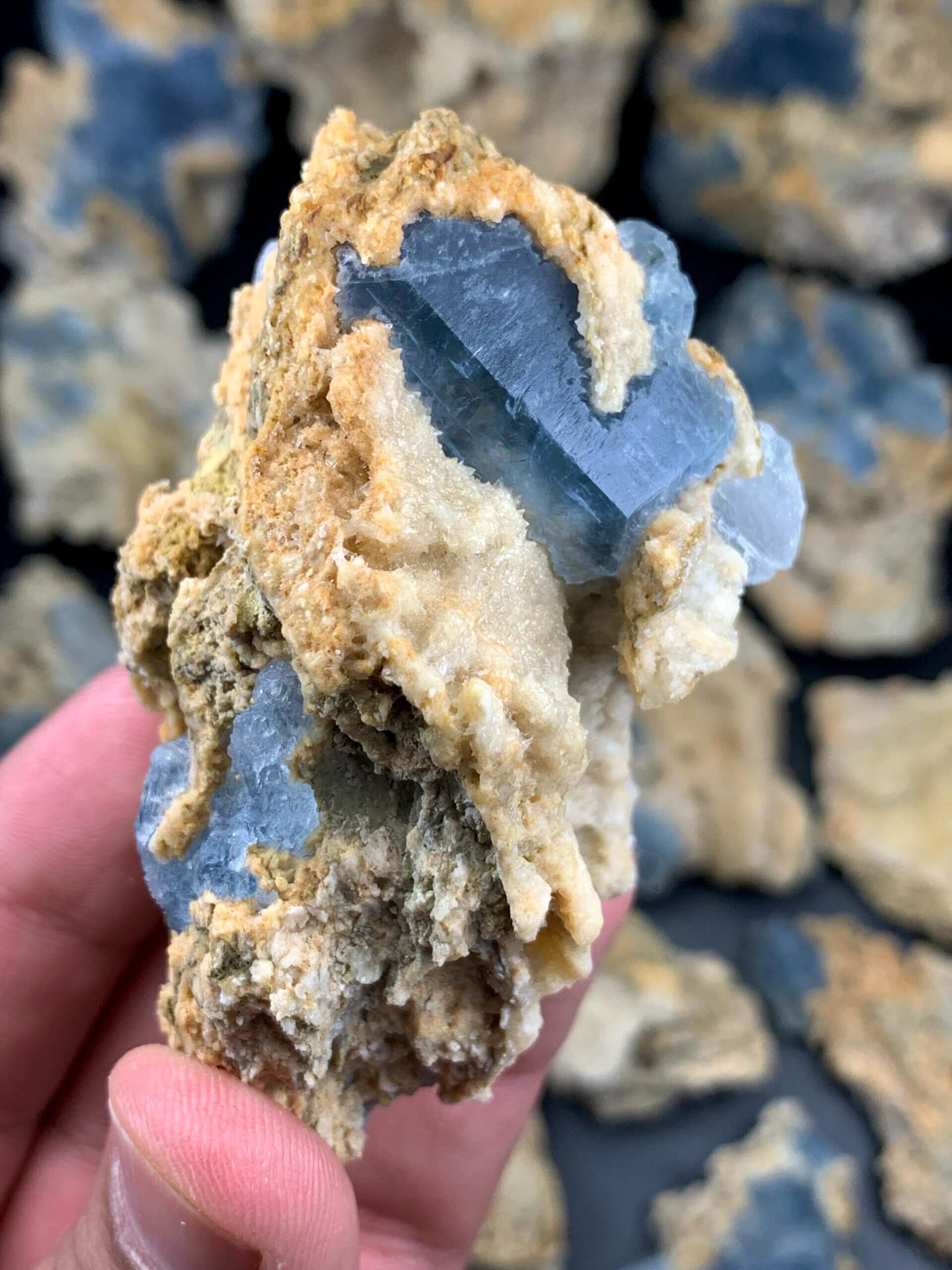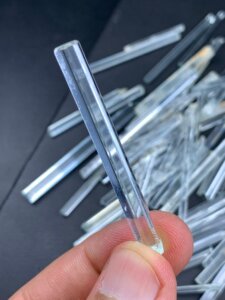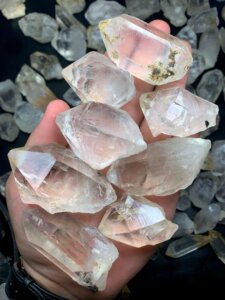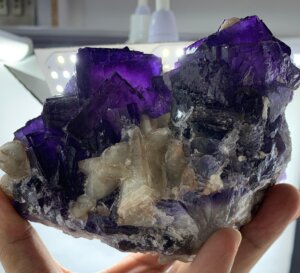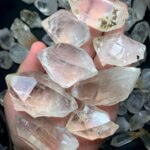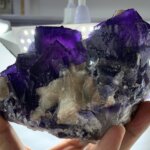Introduction: The Beauty of Afghan Celestine
Among the many mineral treasures found in Afghanistan’s rugged mountains, few match the ethereal charm of Celestine (also known as Celestite). With its sky-blue hues and delicate crystalline formations, Celestine specimens from Badakhshan Afghanistan are becoming increasingly popular among gem collectors and crystal enthusiasts worldwide.
This rare mineral, admired for its purity and gentle glow, represents both geological wonder and aesthetic perfection. Whether you’re a seasoned collector or a gemstone lover seeking a meaningful display piece, Afghan Celestine offers an unmatched balance of rarity, beauty, and value.
What Is Celestine (Celestite)?
Celestine is a strontium sulfate mineral (SrSO₄) known for its soft, blue to bluish-gray color. The name comes from the Latin caelestis, meaning heavenly—a fitting description for its serene, sky-like tones.
Key Physical Properties:
- Chemical Formula: SrSO₄ (Strontium Sulfate)
- Crystal System: Orthorhombic
- Hardness: 3 to 3.5 on Mohs scale
- Color Range: Sky blue, white, colorless, light pink, or pale gray
- Transparency: Transparent to translucent
- Luster: Vitreous to pearly
The most prized pieces are those with intense natural blue coloration and well-formed transparent crystals—qualities that Badakhshan Celestine is especially known for.
The Geological Origin of Celestine Specimens from Badakhshan, Afghanistan
A Region Known for Mineral Wealth
Badakhshan, a remote province in northeastern Afghanistan, is world-famous for its gem-bearing deposits, including lapis lazuli, spinel, and Celestine. The Celestine specimens found here are formed in sedimentary limestone layers and geodes, where mineral-rich groundwater deposits strontium sulfate over millions of years.
Unique Features of Badakhshan Celestine
- Natural Color: The blue coloration of Afghan Celestine is completely natural, with no heat or chemical treatment.
- Crystal Clarity: Many specimens display transparent to translucent crystals with minimal inclusions.
- Cluster Formations: Celestine from this region often occurs as radiating clusters or geode-like cavities, making them ideal for display pieces.
- Rarity: Compared to Madagascar or Ohio Celestine, Afghan varieties are less common in the international market, making them highly collectible.
Why Collect Celestine from Afghanistan?
1. Exceptional Aesthetic Value
Afghan Celestine crystals exhibit an exquisite sky-blue glow under natural light, evoking tranquility and balance. Their crystal geometry and delicate transparency make them standout pieces for mineral showcases.
2. Geographical Rarity
While Celestine is found in several regions worldwide, Badakhshan Celestine combines clarity, color, and unique crystal habits not seen elsewhere. Its limited availability adds to its desirability among collectors.
3. Spiritual and Healing Associations
In metaphysical circles, Celestine is known as a stone of peace, clarity, and divine communication. It’s said to calm the mind, promote intuition, and align higher chakras. Many crystal healers prefer Afghan Celestine for its pure, unaltered energy.
4. Investment and Resale Potential
Because of its natural blue tone and regional rarity, Afghan Celestine often appreciates in value, especially larger or high-quality clusters.
How to Identify Authentic Celestine Specimens from Badakhshan
Tips for Buyers:
- Color Consistency: Genuine Afghan Celestine has soft to medium-blue tones, not overly vivid or artificially bright.
- Transparency: Natural crystals have a subtle internal glow, not glassy reflections.
- Matrix Type: Authentic pieces are often attached to white or gray limestone matrix, typical of Badakhshan deposits.
- Origin Verification: Reputable sellers will specify “Celestine from Badakhshan, Afghanistan” and may provide origin certification.
- Price Awareness: Extremely cheap “blue crystals” may be dyed barite or synthetic substitutes.
The Science Behind Celestine’s Color
The serene blue shade of Celestine results from trace amounts of impurities and crystal lattice defects that scatter light in the blue spectrum. Unlike treated stones, Afghan Celestine’s color is stable and will not fade under normal lighting or display conditions.
To preserve its hue, however, avoid direct, prolonged sunlight or excessive heat, which can gradually lighten the blue tone.
How to Care for Your Celestine Specimen
Celestine is relatively soft and delicate. Follow these simple care tips:
- Avoid Water Exposure: Prolonged soaking can damage or dull its surface.
- Keep Away from Harsh Chemicals: Cleaning agents or acids can erode the crystal.
- Handle Gently: Crystals may chip easily if dropped or knocked.
- Display Indoors: Store or showcase your specimen in a shaded area, away from heat and sunlight.
- Use a Soft Brush: To remove dust, gently brush with a dry, soft-bristled tool.
Buying Guide: How to Choose the Right Celestine Specimen Online
When purchasing Celestine specimens from Badakhshan Afghanistan, consider the following factors to ensure value and authenticity.
1. Evaluate the Color
Look for natural, even blue tones—neither too dark nor too pale. Deep blue specimens are rarer and typically command higher prices.
2. Check the Formation
- Cluster specimens with visible, intact crystals are ideal for collectors.
- Geode halves make stunning home décor or meditation pieces.
- Loose crystals are perfect for jewelry designers or smaller displays.
3. Assess Size and Weight
Larger, intact pieces (especially those above 1 kg) are significantly more valuable due to rarity and transportation difficulty from remote Afghan mines.
4. Verify the Seller
Purchase only from trusted mineral dealers or specialized online stores that source directly from Afghanistan, such as Luminex Specimen. Ensure they provide clear images, origin details, and return policies.
5. Consider Your Purpose
- For collectors → focus on crystal quality and uniqueness.
- For interior décor → choose aesthetic clusters or geodes.
- For spiritual use → select pieces with calming symmetry and vibrant blue energy.
Educational Insight: Celestine in History and Culture
Historically, Celestine has been admired since the 18th century, particularly in Europe, where it was named for its “celestial” hue. Sailors once carried Celestine for safe travel, believing it connected them with the heavens.
In modern times, Celestine is often displayed in museums and mineral fairs, valued both for scientific interest and spiritual symbolism. The Afghan Celestine variety continues to gain recognition for its outstanding purity and provenance.
Common FAQs About Celestine from Badakhshan
1. Is Celestine the same as Celestite?
Yes. “Celestine” and “Celestite” refer to the same mineral (SrSO₄). Both terms are used interchangeably in gemology.
2. Why is Badakhshan Celestine more valuable?
Because of its natural deep blue color, limited mining access, and excellent crystal formations, making it rarer than Celestine from other countries.
3. Can Celestine be used in jewelry?
While possible, it’s generally not recommended due to its softness (3–3.5 Mohs). Celestine is best suited for display specimens or spiritual collections.
4. How can I tell if my Celestine is genuine?
Authentic Celestine is cool to the touch, moderately heavy, and shows natural inclusions or slight color zoning under magnification.
5. Where can I buy authentic Celestine specimens from Afghanistan?
Trusted online mineral suppliers like Luminex Specimen specialize in natural Afghan Celestine crystal lots sourced directly from Badakhshan.
Conclusion: Bring the Sky Indoors with Afghan Celestine
Owning a Celestine specimen from Badakhshan Afghanistan is like holding a piece of the sky itself. Each crystal embodies nature’s artistry, Afghanistan’s mineral legacy, and a sense of calm and wonder unmatched by other stones.
Whether you’re an avid collector, gem enthusiast, or someone drawn to tranquil blue energy, Afghan Celestine is a remarkable addition to any collection.
Explore natural Celestine clusters, geodes, and crystal lots today — and experience the serene beauty that makes Badakhshan’s Celestine truly heavenly.
